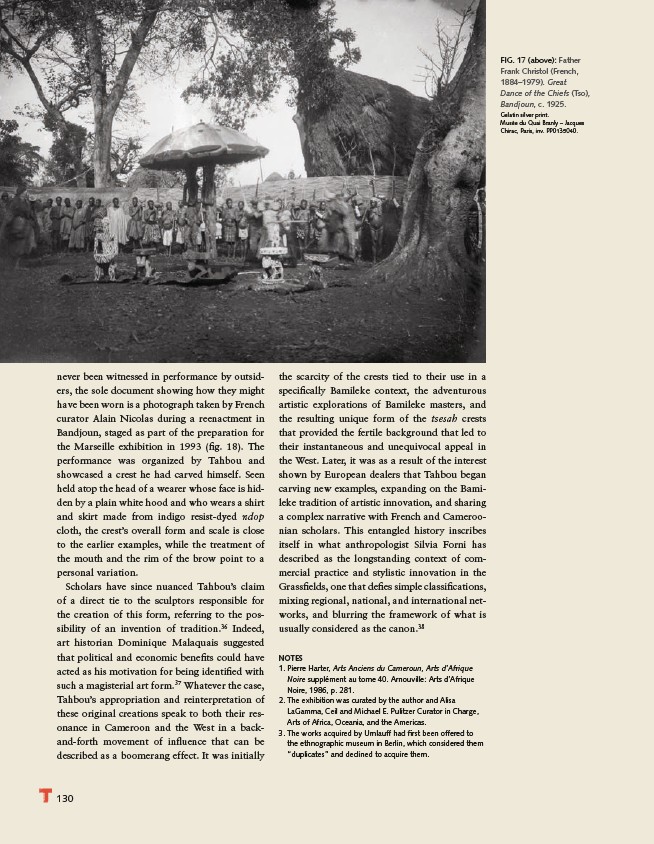
FEATURE
130
FIG. 17 (above): Father
Frank Christol (French,
1884–1979). Great
Dance of the Chiefs (Tso),
Bandjoun, c. 1925.
Gelatin silver print.
Musée du Quai Branly – Jacques
Chirac, Paris, inv. PP0135040.
never been witnessed in performance by outsiders,
the sole document showing how they might
have been worn is a photograph taken by French
curator Alain Nicolas during a reenactment in
Bandjoun, staged as part of the preparation for
the Marseille exhibition in 1993 (fi g. 18). The
performance was organized by Tahbou and
showcased a crest he had carved himself. Seen
held atop the head of a wearer whose face is hidden
by a plain white hood and who wears a shirt
and skirt made from indigo resist-dyed ndop
cloth, the crest’s overall form and scale is close
to the earlier examples, while the treatment of
the mouth and the rim of the brow point to a
personal variation.
Scholars have since nuanced Tahbou’s claim
of a direct tie to the sculptors responsible for
the creation of this form, referring to the possibility
of an invention of tradition.36 Indeed,
art historian Dominique Malaquais suggested
that political and economic benefi ts could have
acted as his motivation for being identifi ed with
such a magisterial art form.37 Whatever the case,
Tahbou’s appropriation and reinterpretation of
these original creations speak to both their resonance
in Cameroon and the West in a backand
forth movement of infl uence that can be
described as a boomerang effect. It was initially
the scarcity of the crests tied to their use in a
specifi cally Bamileke context, the adventurous
artistic explorations of Bamileke masters, and
the resulting unique form of the tsesah crests
that provided the fertile background that led to
their instantaneous and unequivocal appeal in
the West. Later, it was as a result of the interest
shown by European dealers that Tahbou began
carving new examples, expanding on the Bamileke
tradition of artistic innovation, and sharing
a complex narrative with French and Cameroonian
scholars. This entangled history inscribes
itself in what anthropologist Silvia Forni has
described as the longstanding context of commercial
practice and stylistic innovation in the
Grassfi elds, one that defi es simple classifi cations,
mixing regional, national, and international networks,
and blurring the framework of what is
usually considered as the canon.38
NOTES
1. Pierre Harter, Arts Anciens du Cameroun, Arts d’Afrique
Noire supplément au tome 40. Arnouville: Arts d’Afrique
Noire, 1986, p. 281.
2. The exhibition was curated by the author and Alisa
LaGamma, Ceil and Michael E. Pulitzer Curator in Charge,
Arts of Africa, Oceania, and the Americas.
3. The works acquired by Umlauff had fi rst been offered to
the ethnographic museum in Berlin, which considered them
“duplicates” and declined to acquire them.